
Hannah Szenes was a Hungarian Jewish poet and a Special Operations Executive (SOE) member. She was one of 37 Jewish SOE recruits from Mandate Palestine parachuted by the British into Yugoslavia during the Second World War to assist anti-Nazi forces and ultimately in the rescue of Hungarian Jews about to be deported to the German death camp at Auschwitz.
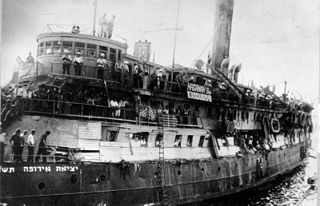
A homeland for the Jewish people is an idea rooted in Jewish history, religion, and culture. The Jewish aspiration to return to Zion, generally associated with divine redemption, has suffused Jewish religious thought since the destruction of the First Temple and the Babylonian exile.

The Jewish Legion was an unofficial name used to refer to five battalions of the British Army's Royal Fusiliers regiment, which consisted of Jewish volunteers recruited during World War I. In 1915, the British Army raised the Zion Mule Corps, a transportation unit of Jewish volunteers, for service in the Gallipoli campaign. Two years later in August 1917, the decision was made to raise an infantry battalion of Jewish soldiers which would be integrated into an existing British Army regiment.

Mount Scopus is a mountain in northeast Jerusalem.

Mount Herzl, also Har ha-Zikaron, is the site of Israel's national cemetery and other memorial and educational facilities, found on the west side of Jerusalem beside the Jerusalem Forest.

The Jewish Infantry Brigade Group, more commonly known as the Jewish Brigade Group or Jewish Brigade, was a military formation of the British Army in the Second World War. It was formed in late 1944 and was recruited among Yishuv Jews from Mandatory Palestine and commanded by Anglo-Jewish officers. It served in the latter stages of the Italian Campaign, and was disbanded in 1946.
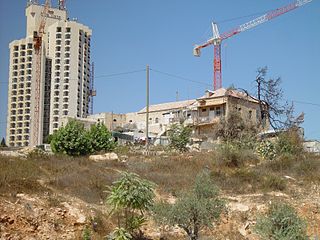
Sheikh Badr was a Palestinian Arab village on a hilltop in west Jerusalem. The Haganah expelled its population during the 1947–1948 Civil War in Mandatory Palestine. From 1948 to 1951, Sheikh Badr Cemetery, a temporary Jewish cemetery was established here; a few hundred graves still remain from that time. After 1949, the area was incorporated into a new area called Givat Ram.

Enzo Sereni was an Italian Socialist Zionist, co-founder of kibbutz Givat Brenner, celebrated intellectual, advocate of Jewish-Arab co-existence and a Jewish Brigade officer who was parachuted into Nazi-occupied Italy in World War II, captured by the Germans and executed in Dachau concentration camp.

Haviva Reik was one of 32 or 33 parachutists sent by the Jewish Agency and Britain's MI9 on military missions in Nazi-occupied Europe. Reik went to Slovakia in fall 1944 and worked with local Jewish people to resist the German occupation there. She established a camp for Russian prisoners of war who had escaped, and helped organize a Jewish resistance unit. The Germans organized forces to put down the Jewish resistance, and Reik and the other parachutists escaped with about 40 local Jews into the mountains. In November 1944, however, Reik and the other parachutists were captured, killed, and buried in a mass grave.

The postage stamps and postal history of Israel is a survey of the postage stamps issued by the state of Israel, and its postal history, since independence was proclaimed on May 14, 1948. The first postage stamps were issued two days later on May 16, 1948. Pre-1948 postal history is discussed in postage stamps and postal history of Palestine.

Events in the year 1944 in the British Mandate of Palestine.

Trumpeldor Cemetery, often referred to as the "Old Cemetery," is a historic cemetery on Trumpeldor Street in Tel Aviv, Israel. The cemetery covers 10.6 acres, and contains approximately 5,000 graves.
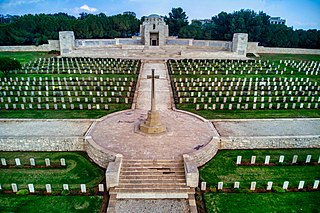
The Jerusalem War Cemetery is a British cemetery in Jerusalem for fallen servicemen of the British Commonwealth in the World War I in the Palestine campaign.
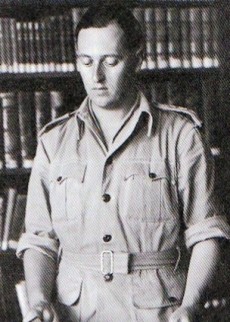
Stephen Norman, born Stephan Theodor Neumann (1918–1946) was the grandson of the founder of Zionism, Theodor Herzl.

Reuven Dafni was a wartime British officer and special forces soldier and a soldier and diplomat for Israel. He was also one of the founders of kibbutz Ein Gev and a longtime assistant director of the Yad Vashem memorial center.
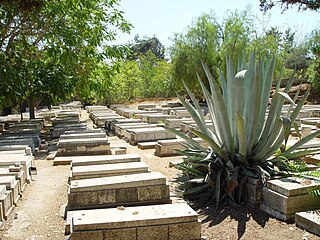
Sheikh Badr Cemetery is an 8 dunams Jewish burial ground in west-central West Jerusalem. It was established as a temporary burial ground during the 1948 Arab siege of Jerusalem. Most of its military and civilian graves were transferred to Mount Herzl and Har HaMenuchot, respectively, in late 1950. The cemetery continued to accept burials up until the official opening of Har HaMenuchot in November 1951.

Sara Braverman was a member of the Jewish Parachutists of Mandate Palestine. She was one of the first female fighters to serve in the Palmach and a founding member of the IDF Women's Corps.

Yoel Palgi was a Palmach parachutist who was dropped by Britain into Yugoslavia during the Second World War to assist in the rescue of Hungarian Jews from the Holocaust and RAF pilots captured by the Germans.

Givat Haviva is the national education center of the Kibbutz Federation in Israel founded in 1949. It is the oldest institution in Israel promoting reconciliation between Jews and Arabs.























